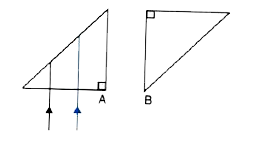Two small angled prisms A and B deviate the blue rays by 6∘ and 8∘ and the red rays by 4∘ and 6∘ respectively. Which prism has a greater dispersive power ?
To determine which prism has a greater dispersive power, we will follow these steps:
Step 1: Understand the concept of dispersive power
Dispersive power (ω) of a prism is defined as the ratio of angular dispersion (the difference in deviation for two colors) to the mean deviation (the average deviation for the two colors).
Step 2: Calculate angular dispersion for prism A
For prism A:
- Deviation for blue rays = 6°
- Deviation for red rays = 4°
Angular dispersion for prism A (ΔA) is calculated as:
ΔA=Deviation for blue rays−Deviation for red rays=6°−4°=2°
Step 3: Calculate mean deviation for prism A
Mean deviation for prism A (M_A) is calculated as:
MA=Deviation for blue rays+Deviation for red rays2=6°+4°2=10°2=5°
Step 4: Calculate dispersive power for prism A
Using the formula for dispersive power:
ωA=ΔAMA=2°5°=0.4
Step 5: Calculate angular dispersion for prism B
For prism B:
- Deviation for blue rays = 8°
- Deviation for red rays = 6°
Angular dispersion for prism B (ΔB) is calculated as:
ΔB=Deviation for blue rays−Deviation for red rays=8°−6°=2°
Step 6: Calculate mean deviation for prism B
Mean deviation for prism B (M_B) is calculated as:
MB=Deviation for blue rays+Deviation for red rays2=8°+6°2=14°2=7°
Step 7: Calculate dispersive power for prism B
Using the formula for dispersive power:
ωB=ΔBMB=2°7°≈0.2857
Step 8: Compare dispersive powers of prisms A and B
Now we compare the dispersive powers:
- Dispersive power of prism A (ω_A) = 0.4
- Dispersive power of prism B (ω_B) ≈ 0.2857
Since ωA>ωB, prism A has a greater dispersive power.
Final Answer
Prism A has a greater dispersive power than prism B.
---
Dispersive power (ω) of a prism is defined as the ratio of angular dispersion (the difference in deviation for two colors) to the mean deviation (the average deviation for the two colors).
For prism A:
- Deviation for blue rays = 6°
- Deviation for red rays = 4°
ΔA=Deviation for blue rays−Deviation for red rays=6°−4°=2°
Mean deviation for prism A (M_A) is calculated as:
MA=Deviation for blue rays+Deviation for red rays2=6°+4°2=10°2=5°
Using the formula for dispersive power:
ωA=ΔAMA=2°5°=0.4
For prism B:
- Deviation for blue rays = 8°
- Deviation for red rays = 6°
ΔB=Deviation for blue rays−Deviation for red rays=8°−6°=2°
Mean deviation for prism B (M_B) is calculated as:
MB=Deviation for blue rays+Deviation for red rays2=8°+6°2=14°2=7°
Using the formula for dispersive power:
ωB=ΔBMB=2°7°≈0.2857
Now we compare the dispersive powers:
- Dispersive power of prism A (ω_A) = 0.4
- Dispersive power of prism B (ω_B) ≈ 0.2857
Prism A has a greater dispersive power than prism B.
Topper's Solved these Questions
- RAY OPTICS AND OPTICAL INSTRUMENTSBOOK - AAKASH INSTITUTE ENGLISHCHAPTER - RAY OPTICS AND OPTICAL INSTRUMENTSEXERCISE - EXERCISE
45 Videos
- RAY OPTICS AND OPTICAL INSTRUMENTSBOOK - AAKASH INSTITUTE ENGLISHCHAPTER - RAY OPTICS AND OPTICAL INSTRUMENTSEXERCISE - ASSIGNMENT (SECTION - A)
39 Videos
- RAY OPTICS AND OPTICAL INSTRUMENTSBOOK - AAKASH INSTITUTE ENGLISHCHAPTER - RAY OPTICS AND OPTICAL INSTRUMENTSEXERCISE - Assignment (Section - J) Aakash Challengers Questions
7 Videos
- PHYSICAL WORLDBOOK - AAKASH INSTITUTE ENGLISHCHAPTER - PHYSICAL WORLDEXERCISE - ASSIGNMENT (Section-B)
4 Videos
- SEMICONDUCTOR ELECTRONICS (MATERIAL, DEVICES AND SIMPLE CIRUITS )BOOK - AAKASH INSTITUTE ENGLISHCHAPTER - SEMICONDUCTOR ELECTRONICS (MATERIAL, DEVICES AND SIMPLE CIRUITS )EXERCISE - Assignment SECTION - D (Assertion & reason type Question)
10 Videos
Similar Questions
A prism of a certain angle deviates the red and blue rays by 8∘ and 12∘ respectively. Another prism of the same angle deviates the red and blue rays by 10∘ and 14∘ respectively. The prisms are small angled and made of different materials. The dispersive powers of the materials of the prisms are in the ratio
View SolutionSuppose a small angled prism of 6∘ deviates a ray through 3∘, then the refractive index is
View Solution
Knowledge Check
A small angled prism (μ=1.62) gives a deviation of 4.8. Calculate the angle of prism.
A5∘B6.36∘C3∘D7.74∘
Compare the dispersive powers of two prisms if one of them deviates the blue and red rays through 10∘ and 6∘ respectively and the second prism through 8∘ and 4.5∘
View SolutionTwo prisms A and B are in contact with each other have angular dispersions of 2∘ and 4∘ respectively. The dispersive power of A is 0.002. If the combination produces dispersion without deviation, the dispersive power of B is
View SolutionThe deviation caused for red, yellow and violet colours for crown glass prism are 2.84∘,3.28∘ and 3.72∘ respectively. The dispersive power of prism material is:
View SolutionFlint glass prism is joined by a crown glass prism to produce dispersion without deviation. The refractive indices of these for mean rays are 1.602 and 1.500 respectively. Angle of prism of flint prism is 10∘, then the angle of prism for crown prism will be
View Solution(a) Figure shows two isosceles right angled prisms A and B and the light rays incident on the prism A. complete the diagram to show the rays emerging out of the prism B.
(b) State the principle used for completing the ray diagram in part (a) above.

View SolutionPrism angle of a prism is 10∘ ,Their refractive index for red & violet color is 1.51&1.52 respectively .Then dispersive power will be
View SolutionAn equilateral prism deviates a ray through23∘for two angles of incidence differing by 23∘findμof the prism?
View Solution
